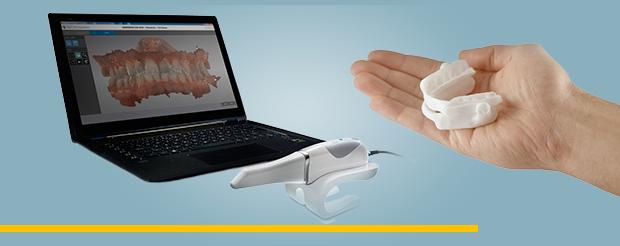Improving Sleep Apnea with Dental Devices

Sleep apnea is a widespread cause of interrupted sleep. Due to its negative effects on physical, mental and even oral health, people have searched for a solution for years. As a result, various alternative therapies have been created alongside trusted techniques such as continuous positive airway pressure (CPAP) therapy and dental appliances. Still, one question remains: which of these techniques really work?
A Common Condition
Sleep apnea is a sleep disorder that occurs when the throat muscles relax during sleep, obstructing the airways and causing loud snoring, periods of being unable to breathe and interrupted sleep.[i]
Although this condition is typically experienced by those over the age of thirty, anyone can develop it at any age. It is estimated that as many as four in every one hundred middle-aged men and two in every one hundred middle-aged women have sleep apnea.[ii]
Sleep and Health
It’s surprising how the amount of sleep we get each night directly affects our daily life. Without proper sleep, our bodies cannot effectively recharge, resulting in many unpleasant side effects.
Sleep and brain functionality are intrinsically linked. Without sleep, it can be difficult to make rational decisions, learn new things or function normally. This is because our brains use sleep time to process information gained throughout the day. If this process is interrupted, mental performance could suffer, leading to headaches, mood swings and accidents due to the lack of concentration.[iii]
Physical health is also impacted by sleep apnea. Extended periods of reduced sleep can lead to the formation of other health conditions, including obesity, heart diseases and diabetes.[iv]
Alternative Methods – Do They Work?
In an age of alternative medicine, it’s not uncommon for people to turn to unconventional treatments for illnesses and conditions. One solution that patients may have tried for sleep apnea is the Buteyko technique. The Buteyko technique emphasizes the importance of breathing through your nose instead of your mouth and claims to help with sleep apnea and other respiratory conditions like asthma.
Those who practice the technique are told to sleep with tape over their mouths, forcing them to breathe through their nose. The technique is designed to stop sleep apnea by preventing the ability to snore. Some establishments that offer Buteyko classes claim that this behavior can improve sleep and the quality of life, as well as improve asthma and allergies by up to 70%.[v]
However, it’s generally agreed among medical professionals that Buteyko is not an appropriate way to treat sleep apnea as the disorder is not solely caused by mouth breathing. An Indonesian singer shocked the world when she revealed that her whole family practices the Buteyko technique, including her young children. This was widely regarded as a dangerous act as restricting a child’s airways during sleep could easily lead to suffocation.[vi]
Another alternative treatment people have tried for sleep apnea is positional therapy. This treatment trains people to sleep in certain positions that may prevent sleep apnea from occurring.[vii] However, positional therapy does not serve as a universal solution and may only work for some.
Dental Devices to the Rescue
As an oral health professional, a solution to offer patients suffering from sleep apnea is a mandibular repositioning device. These custom-made devices move the jaw forward, potentially increasing the size of the upper airway and preventing it from closing.
Fabrication of these devices requires the acquisition of oral impressions which can be made instantly using a digital intraoral scanner. Carestream Dental’s cutting-edge CS 3600 intraoral scanner has multiple functions tailored towards sleep medicine, including a multiple bite capture option which aids the creation of a well-fitting device.
Trust the Science
Although some alternative therapies have few proven benefits, these techniques tend to be less effective than dental devices created by professionals. Educating patients about the benefits of mandibular repositioning and investing in a reliable intraoral scanner can make a remarkable difference in the quality of sleep for patients.
[i] Mayo Clinic. Sleep Apnea. Link: https://www.mayoclinic.org/diseases-conditions/sleep-apnea/symptoms-causes/syc-20377631 [Last accessed July 19].
[ii] Bupa. Obstructive Sleep Apnoea. Link: https://www.bupa.co.uk/health-information/lungs-breathing/obstructive-sleep-apnoea [Last accessed July 19].
[iii] National Heart, Lung and Blood Institute. Sleep Deprivation and Deficiency. Link: https://www.nhlbi.nih.gov/health-topics/sleep-deprivation-and-deficiency [Last accessed July 19].
[iv] National Heart, Lung and Blood Institute. Sleep Deprivation and Deficiency. Link: https://www.nhlbi.nih.gov/health-topics/sleep-deprivation-and-deficiency [Last accessed July 19].
[v] Buteyko Breathing Centre. Home page. Link: https://www.buteyko.co.uk/ [Last accessed July 19].
[vi] BBC News. Buteyko: Why Indonesian Singer Andien Sleeps With Tape on her Mouth. Link: https://www.bbc.co.uk/news/world-asia-48951583 [Last accessed July 19].
[vii] AAST. 5 Alternative Sleep Apnea Treatment Options. Link: https://www.aastweb.org/blog/5-alternative-sleep-apnea-treatment-options [Last accessed July 19].






